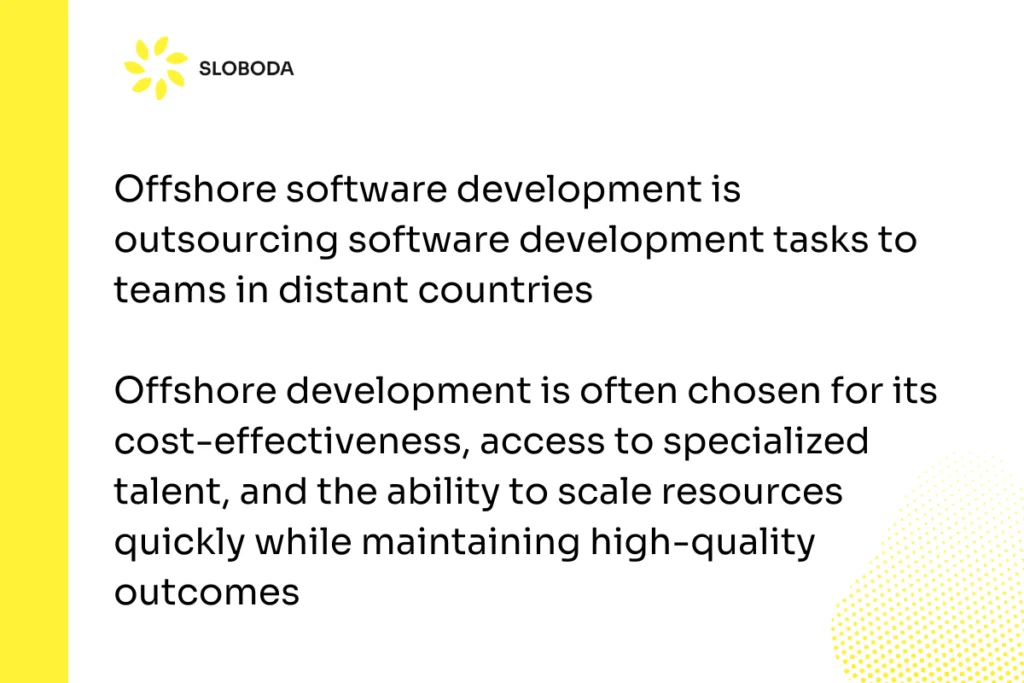If you’re reading this topic, you’re probably seeking ways to maximize efficiency and minimize costs. Enter offshore software development – a strategic approach that can transform your project outcomes. By tapping into global talent pools, you will unlock opportunities for significant savings without compromising quality. But how do you effectively leverage this model?
In this guide, we will discover the ins and outs of offshore development, from selecting the right partners to managing remote teams. Whether you’re a seasoned CTO or a startup founder, you’ll gain valuable insights to optimize your development process and drive your business forward.
What is Offshore Software Development?


Offshore software development involves hiring developers from distant countries to handle complex programming tasks. It’s a strategic approach that has evolved from a cost-saving measure to a global collaboration, offering benefits like:
- Access to specialized talent
- Reduced operational costs
- Faster project delivery
- Enhanced scalability
By leveraging offshore teams, you can tap into a wider pool of expertise while maintaining flexibility in your development process.
Emerging Offshore Software Development Trends


Hybrid Offshore Models: The evolution toward hybrid offshore models is gaining traction, combining the benefits of local oversight with the cost efficiencies and talent diversity of offshore teams. This approach ensures cultural alignment while maximizing operational flexibility and efficiency.
Enhanced Focus on Cybersecurity: In response to escalating cybersecurity threats and tightening global regulations, offshore providers are prioritizing robust security protocols and data privacy measures. Companies are now selecting partners based on their compliance capabilities and ability to safeguard intellectual property.
Expansion into Emerging Markets: The offshore development landscape is broadening, with businesses exploring new technology hubs in Southeast Asia, Latin America, and Africa. These regions are becoming attractive due to their untapped talent pools, cost competitiveness, and innovative potential.
Evolving from Cost-Saving to Innovation: We’re witnessing a shift in offshore development. It’s no longer just about cutting costs; it’s becoming a strategic alliance for innovation. According to Forbes, new models offer access to specialized talent and global in-house centers. You’ll find emerging tech hubs in Southeast Asia and Latin America, providing fresh perspectives and diverse skill sets.
Embracing Cutting-Edge Technologies: Global offshore teams are rapidly adopting AI, cloud-native development, and low-code solutions. These trends are streamlining processes, boosting efficiency, and enabling faster product launches. You’ll see an increased focus on cybersecurity and data privacy, with rigorous protocols being implemented to protect your valuable assets.
Offshore Software Development Pros and Cons
When considering offshore software development, it’s essential to weigh the benefits and challenges to determine if this approach aligns with your business goals. Let’s explore the key advantages and potential drawbacks of offshore software development to help you make an informed decision.
| Offshoring Pros | Offshoring Cons |
|---|---|
| Significant cost savings due to lower labor costs in offshore locations. | Potential communication barriers due to language differences and time zone gaps. |
| Access to a vast global talent pool with specialized expertise. | Quality control can be challenging, with varying standards across regions. |
| Ability to quickly scale development teams based on project needs. | Risk of losing control over critical aspects of the project. |
| 24/7 development cycles leveraging different time zones to speed up project delivery. | Increased risks related to data security, IP protection, and compliance. |
| Frees up in-house teams to focus on strategic priorities and core business functions. | Potential hidden costs related to travel, communication, and project management. |
| Exposure to new perspectives and innovative solutions from diverse cultural backgrounds. | Cultural differences may lead to misunderstandings and slower decision-making. |
Benefits of Offshore Software Development
Offshore software development offers significant advantages for businesses seeking efficiency and innovation. You’ll gain access to a global pool of top tech talent, allowing you to find specialized skills not readily available locally. This approach is also cost-effective, as offshore teams often have lower living costs, reducing overall development expenses. According to Forbes, companies are now forging long-term partnerships to leverage diverse skill sets and fresh perspectives, moving beyond mere cost savings to strategic alliances that drive innovation and growth.
Challenges of Offshore Software Development
Offshore software development presents unique hurdles that can impact project success. Poor communication due to language barriers and cultural differences often leads to misunderstandings. Time zone disparities can delay decision-making and hinder collaboration. Quality control becomes challenging when working with unfamiliar teams, potentially resulting in subpar code. Additionally, intellectual property concerns may arise without proper safeguards. Next chapter, we’ll talk how to mitigate these issues.
Offshore IT Development Best Practices


To maximize the benefits of offshore software development, you need to implement proven best practices. Establish clear communication channels and collaboration processes between your team and the offshore partners. Leverage project management tools to maintain transparency and track progress effectively. Define roles and responsibilities clearly to improve accountability and efficiency. Embrace Agile methodologies to adapt to changing requirements and foster transparency. Remember to account for time zone differences and cultural nuances to ensure smooth collaboration and project success.
Identify the Right Time to Hire Offshore Developers
It would be best if you considered hiring offshore developers when facing local talent shortages, tight deadlines, or complex projects requiring specialized expertise. Offshore teams can provide cost-effective solutions, increased productivity, and access to a vast talent pool. They’re particularly beneficial for startups looking to build MVPs quickly and efficiently. When your in-house team lacks the necessary skills or you need to scale rapidly, offshore developers offer flexibility and specialized knowledge to meet your business goals.
Define Your Vision
Before embarking on offshore development, clearly define your strategic vision and product roadmap. This alignment ensures your offshore team understands project goals and priorities, setting the stage for success.
Looking for offshore developers?
Contact Us
Establish Communication Channels
Develop a robust communication strategy using video conferencing, messaging apps, and project management tools. Regular, transparent communication is crucial for overcoming time zone differences and cultural barriers and fostering collaboration between onshore and offshore teams.
Implement Agile Methodologies
Employ Agile practices to prioritize tasks, ensure iterative development, and adapt to changing requirements. This approach promotes flexibility and efficiency in your offshore software development process, enabling faster time-to-market and higher-quality outcomes.
Read more: Managing Offshore Development Teams
Choosing the Right Offshore Development Partner
Selecting the ideal offshore development partner is crucial for project success. Assess their technical expertise and industry experience through portfolios and case studies. Ensure effective communication by evaluating language skills and time zone compatibility. Consider cultural fit to foster a positive working relationship. Evaluate their quality assurance processes and project management practices. Don’t forget to verify their data security measures and scalability to meet your evolving needs.
What is the Difference Between Onshore, Nearshore, and Offshore Software Development?
| Aspect | Onshore Development | Nearshore Development | Offshore Development |
|---|---|---|---|
| Location | Teams within the same country | Teams in neighboring or nearby countries | Teams in distant, often lower-cost countries |
| Cost | Generally higher due to local wages | Moderate, often lower than onshore but higher than offshore | Lower, taking advantage of reduced labor costs |
| Cultural Alignment | High cultural and business practice alignment | Similar culture and business practices | Potentially significant cultural differences |
| Communication | Easier with no language barriers or time zone differences | Easier communication due to proximity and similar time zones | May face language barriers and time zone challenges |
| Time Zone Differences | Minimal or none | Minimal to moderate time zone overlap | Significant time zone differences |
| Quality Control | Easier to maintain with in-person interactions | Easier to maintain with regular visits if necessary | May require more rigorous remote management |
| Access to Talent | Limited to local talent pool | Access to a broader but regional talent pool | Access to a vast global talent pool |
| Scalability | Limited by local availability | Moderately scalable, depending on regional resources | Highly scalable with large global talent pools |
| Legal and Compliance | Easier to manage under familiar local laws | Generally straightforward, with some regional differences | More complex, involving international laws and compliance |
| Flexibility | High flexibility with local control | Moderate flexibility with some regional advantages | High flexibility in scaling but requires effective remote management |
When considering software development outsourcing, you’ll encounter three main options: onshore, nearshore, and offshore.
Onshore development involves hiring within your country and offering cultural alignment but at higher costs.
Nearshore outsourcing taps into neighboring countries, balancing cost savings with proximity.
Offshore development leverages distant talent pools, providing significant cost benefits but potentially facing communication challenges. Your choice depends on factors like budget, project complexity, and desired workflow.
Conclusion
Remember that project success lies in strategic planning, clear communication, and adaptable management. By leveraging global talent pools and cost advantages, you’re positioning your business for scalable growth and innovation. However, remain vigilant about potential challenges, and invest time in building strong partnerships with your offshore teams.
With the right approach, offshore development can be a game-changer for your company, allowing you to accelerate product development, reduce costs, and stay competitive. Embrace this opportunity to transform your software development process and drive your business forward in the global marketplace.